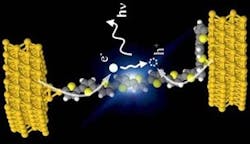Strasbourg, France--A team led by the Institut de Physique et de Chimie des Matériaux de Strasbourg (IPCMS, CNRS/Université de Strasbourg) in collaboration with UPMC and CEA has developed the first ever single-molecule light-emitting diode (LED). The device is formed from a single polythiophene nanowire placed between the tip of a scanning tunneling microscope and a gold surface. It emits light only when the current passes in a certain direction. This tiny LED, described in a Physical Review Letters paper, sheds light on the interactions between electrons and photons at the smallest scales.
To fabricate the LED, the researchers used a single polythiophene nanowire. This substance is a good electricity conductor. It is made of hydrogen, carbon, and sulfur, and is used to make larger LEDs that are already on the market. The polythiophene wire was attached at one end to the tip of a scanning tunneling microscope, and at the other end to a gold surface. The scientists recorded the light emitted when a current passed through this nanowire. They observed that the thiophene wire acts as a light emitting diode: light was only emitted when electrons went from the tip of the microscope towards the gold surface. When the polarity was reversed, light emission was negligible.
In collaboration with a theoretical team from the Service de Physique de l'Etat Condensé (CNRS-CEA/IRAMIS/SPEC), the researchers showed that this light was emitted when a negative charge (an electron) combined with a positive charge (a hole) in the nanowire and transmitted most of its energy to a photon. For every 100,000 electrons injected into the thiophene wire, a photon was emitted. Its wavelength was in the red range.
From a fundamental viewpoint, this device gives researchers a new tool to probe phenomena that are produced when an electrical conductor emits light and it does so at a scale where quantum physics takes precedence over classical physics. Scientists will also be able to optimize substances to produce more powerful light emissions. Finally, this work is a first step towards making molecule-sized components that combine electronic and optical properties. Similar components could form the basis of a molecular computer.
SOURCE: CNRS; http://www.liu.se/forskning/forskningsnyheter/1.541547?l=en

